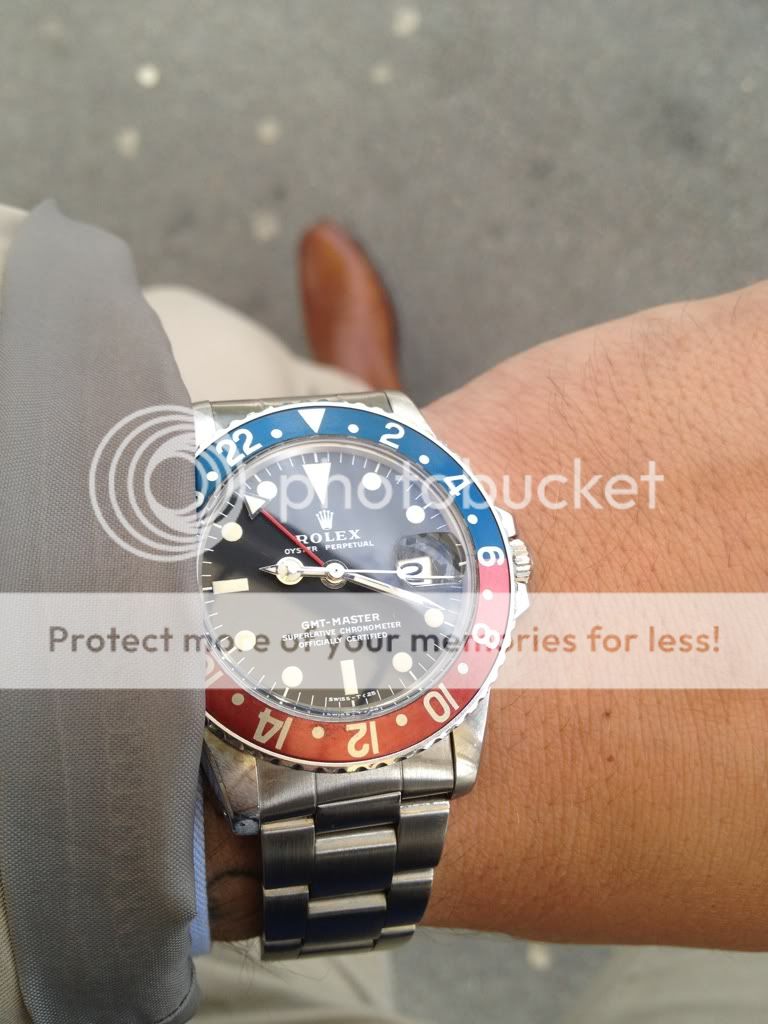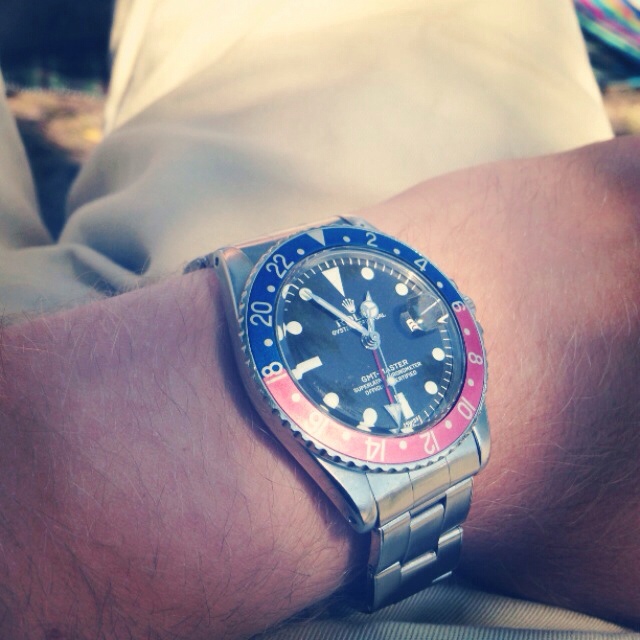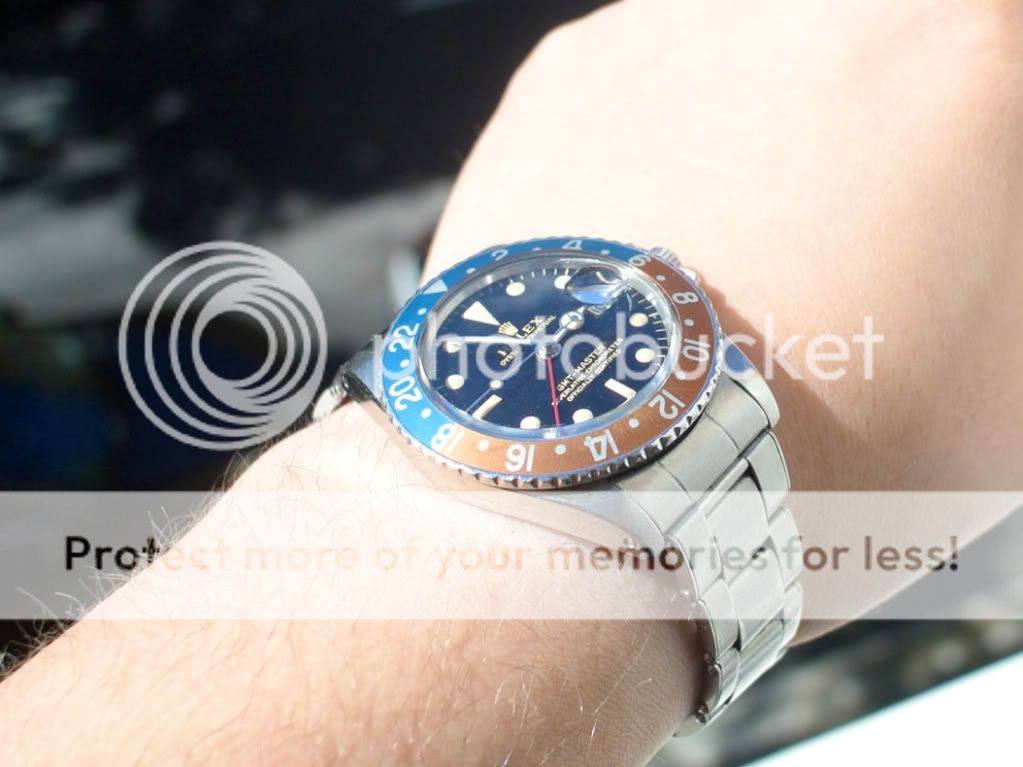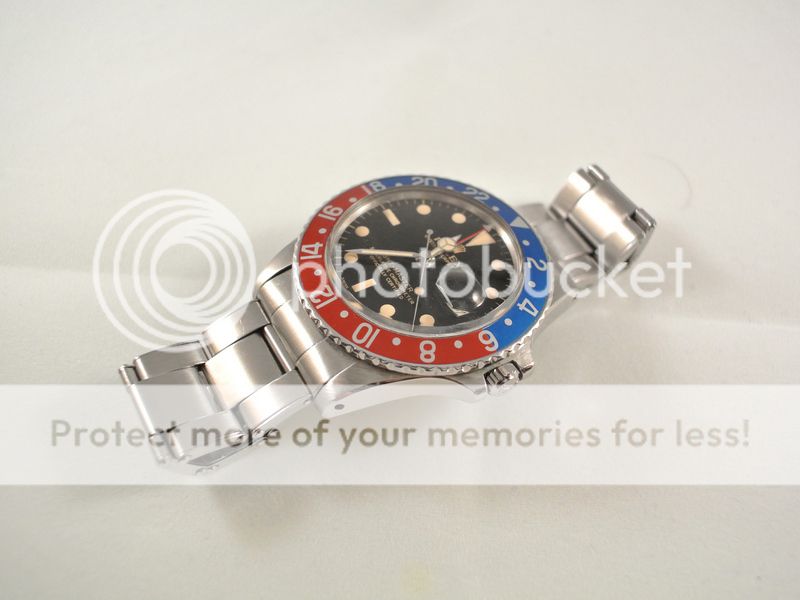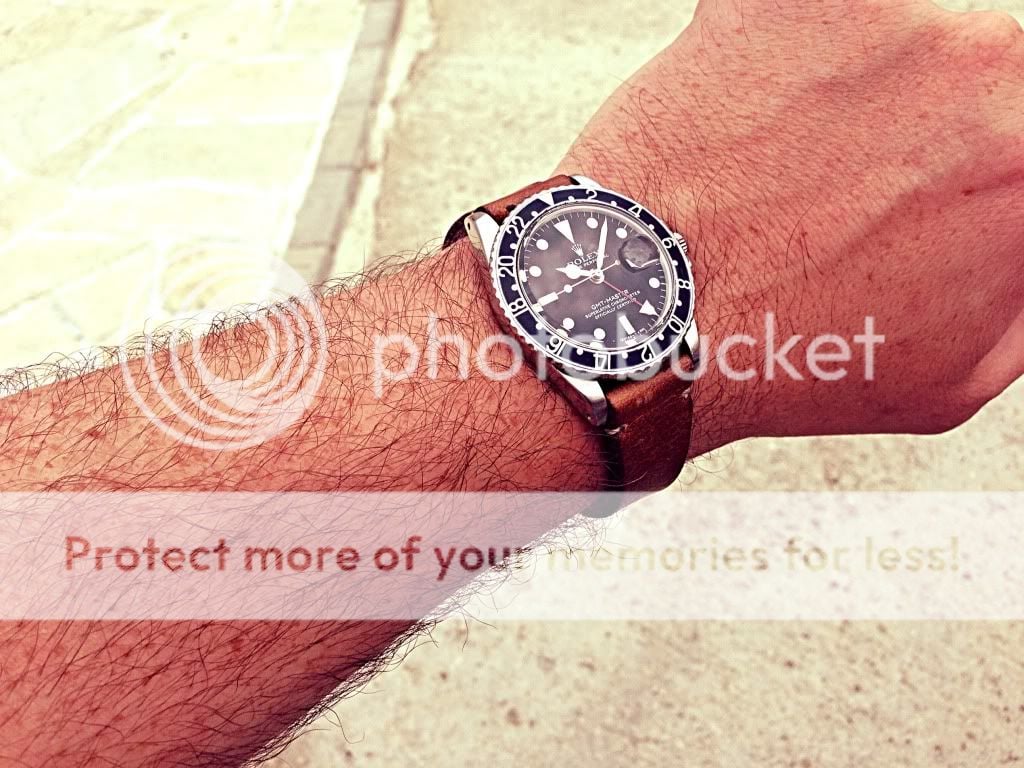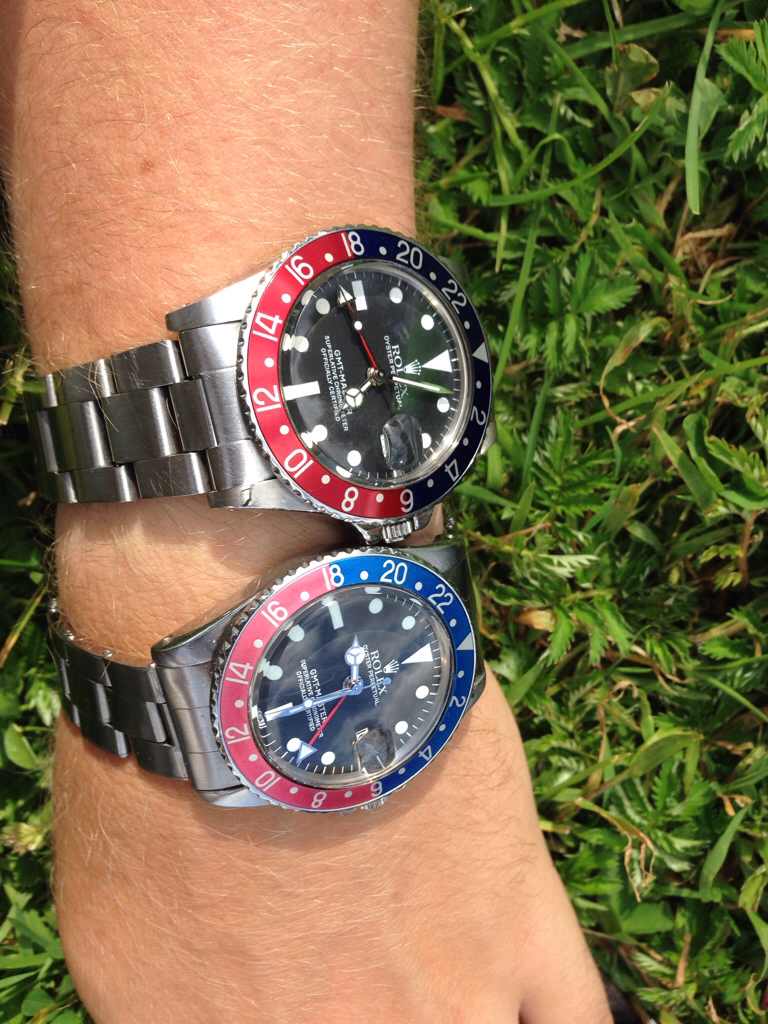Install the app
How to install the app on iOS
Follow along with the video below to see how to install our site as a web app on your home screen.
Notera: This feature may not be available in some browsers.
-
Välkommen till ett uppdaterat Klocksnack.se
Efter ett digert arbete är nu den största uppdateringen av Klocksnack.se någonsin klar att se dagens ljus.
Forumet kommer nu bli ännu snabbare, mer lättanvänt och framför allt fyllt med nya funktioner.Vi har skapat en tråd på diskussionsdelen för feedback och tekniska frågeställningar.
Tack för att ni är med och skapar Skandinaviens bästa klockforum!
/Hook & Leben
You are using an out of date browser. It may not display this or other websites correctly.
You should upgrade or use an alternative browser.
You should upgrade or use an alternative browser.
1675 tråden, har vi någon?
- Trådstartare Robi74
- Start datum
Robi74
Basic
Ditt asHar letat efter ett sådant fint. Vart hitta du det? Lust att hjälpa till att hitta något liknande?
Hehehehe, det gäller att leta under varje sten
Kan du vänta tills den 7e augusti så tror jag att jag har en på G i gbg. Jag tar några kort då och pm'ar dig. Är i Kroatien nu och kommer att träffa killen den 7e augusti i gbg. Vi löser nog en till dig skall du se
Underbart! Hör av dig när du vet! TackHehehehe, det gäller att leta under varje sten
Kan du vänta tills den 7e augusti så tror jag att jag har en på G i gbg. Jag tar några kort då och pm'ar dig. Är i Kroatien nu och kommer att träffa killen den 7e augusti i gbg. Vi löser nog en till dig skall du se
Robi74
Basic
Underbart! Hör av dig när du vet! Tack
Självkart, du har bilder den 7e augusti
...Rolex Coolness From The NASA Archives...
Chic Rolex Space Sheik
NASA Desert Survival Training
Rolex Pepsi GMT Master
I found this fascinating image in the NASA Archives a long time ago. The photo was taken August 14, 1967 during Apollo desert survival training. Apollo 13 Astronaut Jack Swigert is pictured on the far right and he is wearing his Rolex GMT that he wore when he flew to the moon.
Pictured from left to right: Charles M Duke Jr., Thomas K Mattingly, Col. Chester Hohart, and John (Jack) L. Swigert.
No. These guys are not wearing Halloween costumes, and yes they are Sheiks of sorts. In the photo above, the three astronauts are in Washington state during desert survival training. During desert training the astronauts have to simulate what would happen if they land by mistake way off-course in the desert and have to do without human help for several weeks.
So how and why does this make them Sheik's? Arab Sheiks wear cotton scarfs to protect their heads, known as Keffiyeh and robes to stay cool in the extreme heat of the desert. Arab Sheiks also always wear sunglasses, often times indoors because the sun is extremely bright in the desert. The difference between the NASA Astronaut's headpiece and robes is that they are had crafted by the Astronauts from parachutes.

The photo below is of a close up of Jack Swigert's trademark Pepsi Rolex GMT Master. If you look closely it appears that Col. Hobart is also wearing a GMT but on a Jubilee bracelet. Also, digg those chic white Jack Taylor Converse Canvass high-tops Swigert is wearing. I had a pair of those when I was little kid.

Jack Swigert is pictured below in his NASA space suit wearing his Rolex GMT Pepsi.

When Jack Swigert returned from the Apollo 13 Moon Mission, Rolex traded-in his Pepsi GMT Master for a yellow gold Mocha GMT on a Jubilee bracelet as seen below. Jack Swigert's Pepsi GMT Master which traveled to the Moon and back is in Rolex's private collection in Geneva, Switzerland. If you want to learn much more about all of the Rolex Moon watches, you should check out my series aptly named "The Rolex Moon Watch Conquest & Beyond" which covers the entire gamut of Rolex in space.

Taget ifrån http://rolexblog.blogspot.se/2008/11/nasa-apollo-astronaut-jack-swigert.html
Jackie Stewart is a former Scottish race car driving legend. He began his Formula 1 career in 1965 and raced until 1973, and he won three World Drivers Championships.
Jackie Stewart is pictured below with fellow race-car driver and Rolex Daytona wearer, Paul Newman.

Jackie Stewart was a sports commentator during the 1970s on ABC's Wide World Of Sport and we see him below at the the Monaco Grand Prix, giving Argentinian Formula 1 racing legend, Carlos Alberto Reutemann a Rolex GMT Master wrist watch. American's loved his Scottish accent and colorful personality as a sports commentator.

Jackie Stewart is pictured below in 1991 sporting an espresso GMT Master. After Jackie Stewart retired from his racing career, and commentator career, he pursued a successful career in building his own racing team. To this day, Jackie Stewart remains extremely active and travels an average of 300,000 miles a year!

Taget i från http://www.rolexblog.blogspot.se/2008/05/vintage-jackie-stewart-day-date-rolex.html
Jackie Stewart is pictured below with fellow race-car driver and Rolex Daytona wearer, Paul Newman.

Jackie Stewart was a sports commentator during the 1970s on ABC's Wide World Of Sport and we see him below at the the Monaco Grand Prix, giving Argentinian Formula 1 racing legend, Carlos Alberto Reutemann a Rolex GMT Master wrist watch. American's loved his Scottish accent and colorful personality as a sports commentator.

Jackie Stewart is pictured below in 1991 sporting an espresso GMT Master. After Jackie Stewart retired from his racing career, and commentator career, he pursued a successful career in building his own racing team. To this day, Jackie Stewart remains extremely active and travels an average of 300,000 miles a year!

Taget i från http://www.rolexblog.blogspot.se/2008/05/vintage-jackie-stewart-day-date-rolex.html
Apollo 14
Rolex Moon Watches
Pepsi Rolex GMT Master
In the story I wrote the day before yesterday we saw photos of Jack Swigert wearing his Rolex GMT along with a presentation piece that confirmed he wore a Rolex when he went to the moon aboard Apollo XIII. Last month we saw Michael Collins from Apollo 11 wearing a Rolex Turn-O-Graph.I have heard for years that Omega was the official Moon watch. I am not so certain exactly what official means, and if Omega was the official Moon Watch then I think it would be safe to say that Rolex was the "Unofficial Moon Watch."
If we examine the photo below of the three NASA Astronauts that flew to the Moon on board Apollo 14, we see they are all wearing Omega Speedmaster's on the "Outside" of their space suits, not on their wrist. Essentially, they used the Omega Chronograph as a stopwatch.
Let's start by familiarizing ourselves with the crew of the Apollo 14 which was the third manned space mission to land on the Moon, touching down February 5, 1971. From left to right in the photo above are Stuart Roosa (Command Module Pilot), Alan Shepard (Commander) and Edgar Mitchell (Lunar Module Pilot).

Here is where it starts to get really interesting. If you examine Alan Shepard in the photo above, he appears to be wearing a Pepsi Rolex GMT Master on a NATO strap. In Photoshop I zoomed in really deep on his wrist and can see Red & blue on his bezel and the size and shape are consistent with a GMT. It is definitely too small to be an Omega Speedmaster.
In this next photo we see Alan Shepard (light blue shirt) and Ed Mitchell (cap) on a geology field trip, at Craters of the Moon, Idaho on August 22, 1969. Notice that Ed Mitchell is wearing his trademark Pepsi Rolex GMT on his left wrist.

In the image below, the watch really looks to me to be a GMT Master on a NATO strap.

The photo above is of Al Shepard (blue short-sleeve shirt) taken on November 9, 1970.
Next we switch over to Edgar Mitchell's Rolex GMT Master. One obvious question is why is Edgar Mitchell adjusting and winding two Rolex GMT's (as seen in the photo below) just before he boards Apollo 14 to go to the Moon? The answer comes from the photo above that was taken in July of 1970 when Edgar Mitchell (mustard yellow t-shirt) and Alan Shepard (purple shirt) were practicing in the simulator. Notice in the photo above that Edgar Mitchell is wearing what appears to be a Rolex GMT on each wrist.Tip: Click on all images in this story to see much better detail
My best guess is that one GMT was for keeping time on earth at Cape Canaveral as well as Greenwich Mean Time and the other was for measuring some performance characteristic or local time on the Rocket Ship. Also, Edgar Mitchell was well aware of the challenges that Jack Swigert encountered in the previous Apollo XIII mission and knew that his Rolex GMT was a life saver. Maybe he wore two watches for redundancy?

According to NASA this photo (KSC-71P-88) of Ed Mitchell was taken on January 31, 1971 as Ed Mitchell suited up on launch date just before they took off for the Moon. The official NASA caption for this image reads "Ed Mitchell adjusts his watch. 31 January 1971."
It is crystal clear to anybody that the watch NASA officially refers to as Ed Mitchell's watch is a Rolex GMT, which in my mind means that NASA is officially confirming the Rolex to be a Moon Watch!!!!!!
I have not rested my case yet...


These images of the Apollo 14 during take-off toward the heavens are spectacular. Click on them to see all the glorious detail!!!


Alan Shepard on the Moon above.
This next NASA photo is of the NASA Apollo 14 Lunar Module parked on the Moon surface which delivered Dr. Edgar Mitchell and Alan Shepard to the moon surface and returned them to the Service Module.

Apollo 14
Lunar Module Moon Lift-Off
February 6, 1971 18:48:42 UT
Lunar Module Pilot: Dr. Edgar Mitchell
Rolex GMT-Master
The following three photos show Dr. Edgar Mitchell and Alan Shepard as they take-off from the Moon surface to return to the Apollo 14 Command/Service Module in the Grumman-made Lunar Lander module named "Antares." During their moonwalk, Dr. Edgar Mitchell set the all-time record for the longest moonwalk at 9 hours and 17 minutes.
In this first image, we see Alan Shepard putting on his oxygen mask and if you study his facial expression you see a bit of trepidation. After all, he has just experienced the most euphoric experience of his life and he is likely exhausted phyically and mentally–kind of like the way you feel after a full-day of great skiing or snowboarding. He likely realizes if the Lunar Lander does not take-off, they would be stranded on the moon and die.
In the next photo we see Dr. Edgar Mitchell as he prepares the 33,000 pound (15,264kg) Lunar Module (LM) for takeoff–since he was the Lunar Module pilot. We see Dr. Edgar Mitchell wearing his Pepsi GMT Master on his right wrist and we get a clear view of his Rolex Oyster bracelet. He is wearing an Omega Speedmaster Chronograph on a velcro NASA Spec Black Nylon Strap on his left wrist.In the past, Dr. Edgar Mitchell recalled that he wore his Pepsi Rolex GMT Master on the moonwalk, but there has never been any photographic proof to confirm this fact–until today!!!!
This next photo shows Dr. Edgar Mitchell and Alan Shepard very enthusiastically shaking hands in a euphoric and jubilant moment of exultation as they succesfully take-off in the Lunar Module to return to the Service Module from the moon surface!!!!
Pictured below is Stu Roosa (left), Al Shepard (center) and Ed Mitchell (right) in the isolation van. Roosa is using a the microphone to talk to bystanders on February 9, 1971. Ed Mitchell is wearing his Rolex GMT on his right wrist in both the photo above and below.

Ed Mitchell is pictured below during a 15 day quarantine in the MSC Lunar Receiving Laboratory at the Lyndon Johnson Space Center in Houston Texas, holding a sample collection as he shows them to NASA management during a post-mission debrief with geologists on February 18, 1971. Ed is wearing his trademark Stainless Steel Pepsi Rolex GMT Master.

Källa: http://www.rolexblog.blogspot.se/2008/06/apollo-14-rolex-story.html
Part 1
Apollo 17
Rolex Moon Watch
Pepsi Rolex GMT Master
Heritage Auction Galleries Sold
The First Rolex Moon Watch Ever Auctioned
Sold For $131,450!!!
Auction Date: October 8, 2009
Heritage Auction Galleries in Dallas, Texas is internationally renowned for auctioning extremely rare collectibles and in their Space Auction today they sold the first Rolex Moon watch to ever be auctioned for $131,450.
This is perhaps the most historically significant Rolex on earth, or certainly one of them–a Rolex Moon Watch.
To see the watch lot on Heritage Auction Galleries please click here. To view the Space Auction catalog please click here.
A Rolex GMT Master Known To Have Landed On the Surface Of The Moon
One of the many things that sets this Rolex GMT Master apart is it was worn to the Moon and back and spent a great deal of time on the Moon surface. To be specific, the watch was Commander Ronald Evans personal Rolex GMT Master watch he placed in his Personal Preference Kit (PPK) and flew to the Moon with.
Once the Apollo team reached the moon, Commander Ronald Evans asked his crewmates Gene Cernan and Harrsion Schmitt to take his personal Rolex GMT Master aboard the Lunar Module Challenger down to the Moon surface while he orbited the moon in the Command Module America.
According to Heritage Auction Galleries, Commander Ronald Evans Rolex "remained on the moon for approximately seventy-five hours on what up to this day, was the last manned lunar landing mission."

Commander Ronald Evans Rolex Moon Watch With Original Box & Papers
This is an extremely profound story that ads another huge piece of the puzzle to the Rolex Moon Watch Mystery. Before we go in to the details of this mystery let's examine this historic Rolex Moon Watch.
It was worn by United States NASA Apollo Commander Ronald Evans on Apollo 17 which was the last manned Moon Mission. Commander Ronald "Ron" Evans is pictured below in his official NASA Apollo 17 portrait standing in front of a Moon Globe.
Ronald Ellwin Evans Jr., was born on November 10, 1933 and passed away on April 7, 1990. He achieved the Boy Scouts Of America's second highest rank of Life Scout. and recieved a Bachelor Of Science degree in Electrical Engineering from the University of Kansas in 1956. In 1964 he earned a Master Of Science degree in Aeronautical Engineering from the U.S. Naval Postgraduate School.
Evans went on to become a U.S. Navy pilot flying an F-8 Crusader aircraft from the very USS Ticonderoga that would pick him up from splashdown in the Pacific after his successful Apollo 17 Moon Mission.
Commander Evans retired from the U.S. Navy as a Captain and was one of the only 24 people to ever fly to the Moon.

In the close-up Photo below we see NASA Apollo 17 Astronaut Commander Ronald Evans 1968 Pepsi Rolex GMT Master [Reference 1675, Caliber 1580, Serial Number 2448718] that spent time on the lunar surface.

This major piece of the Rolex Moon Watch history puzzle answers many question and at the same time brings to light more fascinating questions.
As we see evidenced in the photo below, when Commander Evans returned from the Moon he proudly hand-engraved the provenance on the back of this Pepsi Rolex GMT Master. He inscribed "FLOWN ON APOLLO XVII 6-19 DEC 72 ON MOON 11-17 DEC RON EVANS." Apparently Commander Evans hand engraved this without removing the Rolex Oyster bracelet.

Part of the provenance includes this letter from Jan Evans (Commander Evans wife) that documents the Rolex was worn to the moons lunar surface and that is has been in the family collection all these years.

The Rolex Moon Watch Mystery
We have just examined what is arguably one of the most historically significant Rolex watches on earth–and the moon for that matter. In order to truly understand the historical significance of this Pepsi GMT Master we must delve deeper into its context since context gives content its meaning.
One day, in the future, I will write The Complete History Of The Rolex Moon Watches, but today we will take a broad overview. One of the things I always do on Jake's Rolex Watch Blog is attempt to separate the fact from the fiction.
Over the years much speculation and conjecture have been put forth as fact and from the in-depth research I have completed, most of it is far, far from the truth. The Rolex Moon Watches have been highly subjected to these false myths. My object as a historian and scientist is to bring the truth to light.
Donald Kent "Deke" Slayton was chosen as one of the original Seven Mercury Astronauts but was the only one who did not fly since his "Delta 7" was grounded because he suffered from an erratic heart rate, known in technical terms as idiopathic atrial fibrillation. Scott Carpenter took Deke Slayton's place when he flew his Aurora 7.
 In the photo above we see the Original 7 Mercury Astronauts at the White House receiving the Collier Trophy. The NASA caption reads "NASA Administrator James E. Webb (center) cites the space achievements of the Project Mercury Astronauts who recieved the 1963 Collier Trophy Award in a ceremony held at the White House on October 10, 1963. President John F. Kennedy (left) and Vice President Lyndon Johnson accompanied Webb at the ceremony. Five of the seven astronauts are visible in the row behind James Webb.. They are (starting from JFK's left): Alan Shepard, Donald "Deke" Slayton, John Glenn, Virgil "Gus" Grissom, and Scott Carpenter."
In the photo above we see the Original 7 Mercury Astronauts at the White House receiving the Collier Trophy. The NASA caption reads "NASA Administrator James E. Webb (center) cites the space achievements of the Project Mercury Astronauts who recieved the 1963 Collier Trophy Award in a ceremony held at the White House on October 10, 1963. President John F. Kennedy (left) and Vice President Lyndon Johnson accompanied Webb at the ceremony. Five of the seven astronauts are visible in the row behind James Webb.. They are (starting from JFK's left): Alan Shepard, Donald "Deke" Slayton, John Glenn, Virgil "Gus" Grissom, and Scott Carpenter."
Deke Slayton retired from NASA and the Air Force in 1963 and was rehired by NASA in a civilian capacity as Director Of Flight Operations and in that capacity he chose the primary and backup crews for the Gemini and Apollo programs. This decision-making authority included who would be the first astronaut to step on the Moon surface.
From the research I have completed it appears Deke Slayton was also the person who decided to make Omega the official watch of NASA. I have heard conflicting accounts of how this process occurred and I don't know which account is true.
The best I can do is share both sides of the coin with you. There are many accounts about how Omega was chosen as the Official Moon Watch. These account suggest there was a test process, but I have seen zero evidence to corroborate this account.
If you have or know of specific NASA data or a report on this supposed watch testing procedure, please email it to me and I will publish it.
I have also heard that Deke Slayton or somebody at NASA held an invisible auction that approached the major watch manufactures to make them the Official NASA watch. Apparently Rolex was approached and ironically refused to participate in the auction!!!
Rolex argued they made the best watch and they refused to pay to be the official watch since the watch chosen should be based on the merit of the watch and they knew they had the best watch.
As the story goes, Omega shrewdly jumped in and bought the title in some kind of back room envelope-filled-with-hundred-dollar bills deal. (This was perhaps the first time Omega did this but not the last. Of course they tried to step in and replace Rolex as the James Bond watch).
I can't prove this because I was not there. I can only share my research findings with you. I will say I believe Rolex made a huge mistake that would probably be their greatest blunder in history by not becoming the official NASA space watch.
Once again, as I previously mentioned, in the future I will go into more detail on my historical findings on this subject in a detailed story.
Buck Rogers In The 20Th Century
The NASA space program with its goal to put a man on the Moon was extremely exciting stuff. As my Uncle Chris said "It was right out of Buck Rogers!!!!!!!!!!!!!!!!"
In the photo below we see NASA Gemini IV astronauts Edward H. White II (left) and James A McDivitt inside the Gmini IV spacecraft preparing for liftoff in early June of 1965.

On June 3, 1965 NASA Gemini IV Astronaut Edward H. White II became the first American to climb outside his spacecraft and set himself adrift in the zero gravity of space. White floated around for 23 minutes. Edward White was wearing an Omega Speedmaster chronograph around his wrist–outside his space suit on a velcro strap.

The Omega Speedmaster chronograph (which is a very cool watch by the way) was a manual-wind watch because it was falsely put forth that an automatic Rolex Perpetual self-winding, rotor-based watch would not function in the zero gravity environment of outer space. NASA astronaut Leroy Chaio busted that myth on Jake's Rolex Watch Blog.

Can you imagine how blown-away NASA Gemini IV Astronaut Edward White must have been to be able to float in zero-gravity above the beautiful Earth!!!!! These photos that were taken before I was born still take my breath away!!!!
Apollo 13
To best understand Ronald Evans' Rolex story, let's jump ahead to the Apollo 13 Moon Mission. In the photo below we see the Apollo 13 Prime crew eating their traditional Steak and Eggs breakfast on the morning of their flight. Notice that Jack Swigert is wearing his Rolex Pepsi GMT.

In this next photo we see a close-up of Jack Swigert wearing his Pepsi Rolex GMT that he wore to the moon.

Apollo 13 made it to the Moon's orbit, then all hell broke loose. The lives of the Apollo 13 crew members were in serious jeopardy and in the photo below we see Ronald Evans monitoring the Apollo 13 mission with members of the next-to-fly Apollo 14 crew.

Fortunately Apollo 13 made it back safely to Earth and Rolex rewarded Jack Swigert with a Yellow Gold Mocha GMT Master on a Jubilee bracelet which is pictured below. Jack Swigert gave Rolex his Pepsi GMT which is located today in Rolex World Headquarters in Geneva, Switzerland.

Apollo 14
I was the first historian to document the fact Ronald Evans wore his GMT which I found in this photo in the NASA archives and published two years ago. Ronald Evans was on the backup crew for Apollo 14 and you see him in the photo below on the far right wearing his Pepsi Rolex GMT Master which is for sale in the Heritage Auction Galleries sale on October 8, 2009. In this photo we see the Apollo 14 crew during their Steak and Eggs breakfast before they take off for the moon.

In the Steak and Eggs breakfast photo above taken on January 31, 1971, we see Dr. Edgar Mitchell located on the far left. An hour or so later we see him in the picture below as he prepares to board the Apollo 14 Mission to go to the Moon. Notice he is setting the time on his two Pepsi Rolex GMT Master watches.

Apollo 17
In the photo below we see the Prime Crew of Apollo 17 posing in front of the Saturn Rocket that would soon take them safely to the Moon and back. We see Eugene Cernan sitting on the lunar probe with Harrison Schmitt pictured next to Ronald Evans.

Lunar Module Pilot Harrison Schmitt is pictured below in his official NASA Apollo 17 portrait.

The Last Man On The Moon
Apollo 17 Mission Commander Eugene A. Cernan is pictured below in his official NASA Apollo 17 portrait. Eugene Cernan flew in the Gemini IX mission as well as on Apollo 10 and as part of Apollo 17 would be the last man to walk on the Moon.

Apollo 17
Rolex Moon Watch
Pepsi Rolex GMT Master
Heritage Auction Galleries Sold
The First Rolex Moon Watch Ever Auctioned
Sold For $131,450!!!
Auction Date: October 8, 2009
Heritage Auction Galleries in Dallas, Texas is internationally renowned for auctioning extremely rare collectibles and in their Space Auction today they sold the first Rolex Moon watch to ever be auctioned for $131,450.
This is perhaps the most historically significant Rolex on earth, or certainly one of them–a Rolex Moon Watch.
To see the watch lot on Heritage Auction Galleries please click here. To view the Space Auction catalog please click here.
A Rolex GMT Master Known To Have Landed On the Surface Of The Moon
One of the many things that sets this Rolex GMT Master apart is it was worn to the Moon and back and spent a great deal of time on the Moon surface. To be specific, the watch was Commander Ronald Evans personal Rolex GMT Master watch he placed in his Personal Preference Kit (PPK) and flew to the Moon with.
Once the Apollo team reached the moon, Commander Ronald Evans asked his crewmates Gene Cernan and Harrsion Schmitt to take his personal Rolex GMT Master aboard the Lunar Module Challenger down to the Moon surface while he orbited the moon in the Command Module America.
According to Heritage Auction Galleries, Commander Ronald Evans Rolex "remained on the moon for approximately seventy-five hours on what up to this day, was the last manned lunar landing mission."

Commander Ronald Evans Rolex Moon Watch With Original Box & Papers
This is an extremely profound story that ads another huge piece of the puzzle to the Rolex Moon Watch Mystery. Before we go in to the details of this mystery let's examine this historic Rolex Moon Watch.
It was worn by United States NASA Apollo Commander Ronald Evans on Apollo 17 which was the last manned Moon Mission. Commander Ronald "Ron" Evans is pictured below in his official NASA Apollo 17 portrait standing in front of a Moon Globe.
Ronald Ellwin Evans Jr., was born on November 10, 1933 and passed away on April 7, 1990. He achieved the Boy Scouts Of America's second highest rank of Life Scout. and recieved a Bachelor Of Science degree in Electrical Engineering from the University of Kansas in 1956. In 1964 he earned a Master Of Science degree in Aeronautical Engineering from the U.S. Naval Postgraduate School.
Evans went on to become a U.S. Navy pilot flying an F-8 Crusader aircraft from the very USS Ticonderoga that would pick him up from splashdown in the Pacific after his successful Apollo 17 Moon Mission.
Commander Evans retired from the U.S. Navy as a Captain and was one of the only 24 people to ever fly to the Moon.

In the close-up Photo below we see NASA Apollo 17 Astronaut Commander Ronald Evans 1968 Pepsi Rolex GMT Master [Reference 1675, Caliber 1580, Serial Number 2448718] that spent time on the lunar surface.

This major piece of the Rolex Moon Watch history puzzle answers many question and at the same time brings to light more fascinating questions.
As we see evidenced in the photo below, when Commander Evans returned from the Moon he proudly hand-engraved the provenance on the back of this Pepsi Rolex GMT Master. He inscribed "FLOWN ON APOLLO XVII 6-19 DEC 72 ON MOON 11-17 DEC RON EVANS." Apparently Commander Evans hand engraved this without removing the Rolex Oyster bracelet.

Part of the provenance includes this letter from Jan Evans (Commander Evans wife) that documents the Rolex was worn to the moons lunar surface and that is has been in the family collection all these years.

The Rolex Moon Watch Mystery
We have just examined what is arguably one of the most historically significant Rolex watches on earth–and the moon for that matter. In order to truly understand the historical significance of this Pepsi GMT Master we must delve deeper into its context since context gives content its meaning.
One day, in the future, I will write The Complete History Of The Rolex Moon Watches, but today we will take a broad overview. One of the things I always do on Jake's Rolex Watch Blog is attempt to separate the fact from the fiction.
Over the years much speculation and conjecture have been put forth as fact and from the in-depth research I have completed, most of it is far, far from the truth. The Rolex Moon Watches have been highly subjected to these false myths. My object as a historian and scientist is to bring the truth to light.
Donald Kent "Deke" Slayton was chosen as one of the original Seven Mercury Astronauts but was the only one who did not fly since his "Delta 7" was grounded because he suffered from an erratic heart rate, known in technical terms as idiopathic atrial fibrillation. Scott Carpenter took Deke Slayton's place when he flew his Aurora 7.
 In the photo above we see the Original 7 Mercury Astronauts at the White House receiving the Collier Trophy. The NASA caption reads "NASA Administrator James E. Webb (center) cites the space achievements of the Project Mercury Astronauts who recieved the 1963 Collier Trophy Award in a ceremony held at the White House on October 10, 1963. President John F. Kennedy (left) and Vice President Lyndon Johnson accompanied Webb at the ceremony. Five of the seven astronauts are visible in the row behind James Webb.. They are (starting from JFK's left): Alan Shepard, Donald "Deke" Slayton, John Glenn, Virgil "Gus" Grissom, and Scott Carpenter."
In the photo above we see the Original 7 Mercury Astronauts at the White House receiving the Collier Trophy. The NASA caption reads "NASA Administrator James E. Webb (center) cites the space achievements of the Project Mercury Astronauts who recieved the 1963 Collier Trophy Award in a ceremony held at the White House on October 10, 1963. President John F. Kennedy (left) and Vice President Lyndon Johnson accompanied Webb at the ceremony. Five of the seven astronauts are visible in the row behind James Webb.. They are (starting from JFK's left): Alan Shepard, Donald "Deke" Slayton, John Glenn, Virgil "Gus" Grissom, and Scott Carpenter."Deke Slayton retired from NASA and the Air Force in 1963 and was rehired by NASA in a civilian capacity as Director Of Flight Operations and in that capacity he chose the primary and backup crews for the Gemini and Apollo programs. This decision-making authority included who would be the first astronaut to step on the Moon surface.
From the research I have completed it appears Deke Slayton was also the person who decided to make Omega the official watch of NASA. I have heard conflicting accounts of how this process occurred and I don't know which account is true.
The best I can do is share both sides of the coin with you. There are many accounts about how Omega was chosen as the Official Moon Watch. These account suggest there was a test process, but I have seen zero evidence to corroborate this account.
If you have or know of specific NASA data or a report on this supposed watch testing procedure, please email it to me and I will publish it.
I have also heard that Deke Slayton or somebody at NASA held an invisible auction that approached the major watch manufactures to make them the Official NASA watch. Apparently Rolex was approached and ironically refused to participate in the auction!!!
Rolex argued they made the best watch and they refused to pay to be the official watch since the watch chosen should be based on the merit of the watch and they knew they had the best watch.
As the story goes, Omega shrewdly jumped in and bought the title in some kind of back room envelope-filled-with-hundred-dollar bills deal. (This was perhaps the first time Omega did this but not the last. Of course they tried to step in and replace Rolex as the James Bond watch).
I can't prove this because I was not there. I can only share my research findings with you. I will say I believe Rolex made a huge mistake that would probably be their greatest blunder in history by not becoming the official NASA space watch.
Once again, as I previously mentioned, in the future I will go into more detail on my historical findings on this subject in a detailed story.
Buck Rogers In The 20Th Century
The NASA space program with its goal to put a man on the Moon was extremely exciting stuff. As my Uncle Chris said "It was right out of Buck Rogers!!!!!!!!!!!!!!!!"
In the photo below we see NASA Gemini IV astronauts Edward H. White II (left) and James A McDivitt inside the Gmini IV spacecraft preparing for liftoff in early June of 1965.

On June 3, 1965 NASA Gemini IV Astronaut Edward H. White II became the first American to climb outside his spacecraft and set himself adrift in the zero gravity of space. White floated around for 23 minutes. Edward White was wearing an Omega Speedmaster chronograph around his wrist–outside his space suit on a velcro strap.

The Omega Speedmaster chronograph (which is a very cool watch by the way) was a manual-wind watch because it was falsely put forth that an automatic Rolex Perpetual self-winding, rotor-based watch would not function in the zero gravity environment of outer space. NASA astronaut Leroy Chaio busted that myth on Jake's Rolex Watch Blog.

Can you imagine how blown-away NASA Gemini IV Astronaut Edward White must have been to be able to float in zero-gravity above the beautiful Earth!!!!! These photos that were taken before I was born still take my breath away!!!!
Apollo 13
To best understand Ronald Evans' Rolex story, let's jump ahead to the Apollo 13 Moon Mission. In the photo below we see the Apollo 13 Prime crew eating their traditional Steak and Eggs breakfast on the morning of their flight. Notice that Jack Swigert is wearing his Rolex Pepsi GMT.

In this next photo we see a close-up of Jack Swigert wearing his Pepsi Rolex GMT that he wore to the moon.

Apollo 13 made it to the Moon's orbit, then all hell broke loose. The lives of the Apollo 13 crew members were in serious jeopardy and in the photo below we see Ronald Evans monitoring the Apollo 13 mission with members of the next-to-fly Apollo 14 crew.

Fortunately Apollo 13 made it back safely to Earth and Rolex rewarded Jack Swigert with a Yellow Gold Mocha GMT Master on a Jubilee bracelet which is pictured below. Jack Swigert gave Rolex his Pepsi GMT which is located today in Rolex World Headquarters in Geneva, Switzerland.

Apollo 14
I was the first historian to document the fact Ronald Evans wore his GMT which I found in this photo in the NASA archives and published two years ago. Ronald Evans was on the backup crew for Apollo 14 and you see him in the photo below on the far right wearing his Pepsi Rolex GMT Master which is for sale in the Heritage Auction Galleries sale on October 8, 2009. In this photo we see the Apollo 14 crew during their Steak and Eggs breakfast before they take off for the moon.

In the Steak and Eggs breakfast photo above taken on January 31, 1971, we see Dr. Edgar Mitchell located on the far left. An hour or so later we see him in the picture below as he prepares to board the Apollo 14 Mission to go to the Moon. Notice he is setting the time on his two Pepsi Rolex GMT Master watches.

Apollo 17
In the photo below we see the Prime Crew of Apollo 17 posing in front of the Saturn Rocket that would soon take them safely to the Moon and back. We see Eugene Cernan sitting on the lunar probe with Harrison Schmitt pictured next to Ronald Evans.

Lunar Module Pilot Harrison Schmitt is pictured below in his official NASA Apollo 17 portrait.

The Last Man On The Moon
Apollo 17 Mission Commander Eugene A. Cernan is pictured below in his official NASA Apollo 17 portrait. Eugene Cernan flew in the Gemini IX mission as well as on Apollo 10 and as part of Apollo 17 would be the last man to walk on the Moon.

Part 2
This next image of Eugene "Gene" Andrew Cernan is very interesting because he is wearing a Pepsi Rolex GMT Master on the outside of his space suit on a velcro strap!?! This photo just ads to the Rolex Moon Watch Mystery because the obvious question is if Omega was the official watch of NASA then what is an Apollo astronaut doing wearing a Rolex on the outside of his space suit!?!
The Saturn Rocket that would take the Apollo 17 prime crew to the moon is pictured below on its launch pad.

Apollo 17 was the first mission to be launched at night.

In this next photo we see NASA Apollo 17 Commander Ronald Evans with Gene Cernan as they head to the moon. It is fascinating to think the watch in this auction was likely on Ronald Evans wrist when this photo was taken.
The Blue MarbleAs the Apollo 17 Mission sped away from Earth on December 7, 1972 to the Moon Ronald Evans took this very famous photo of the Earth known as "The Blue Marble." Antarctica is pictured on the bottom and we see the eastern coastline of Africa and the Island of Madagascar as well as the Gulf of Aden, the Red Sea and the Arabian Peninsula.

Apollo 17 was the last of seven manned lunar landing missions. The photo below was taken by Lunar Module Pilot Harrison Schmitt of Apollo 17 Commander Gene Cernan as he he adjusts the U.S. Flag on the lunar surface on December 12, 1972. Notice the Earth in the background looking the way the Moon looks from Earth.
The scientific objectives of Apollo 17 included geological surveying as well as sampling materials and surface features in the Taurus-Littrow region of the Moon. This included exploring atmospheric composition experiments that included Lunar ejecta and meteorites.Lunar Module Pilot Harrison Schmitt is pictured below examining a large Moon boulder.

In the photo below we see the Lunar Rover vehicle which was deployed as part of the Apollo 17 Moon mission.

The Apollo 17 Moon Mission was the longest Apollo mission in history lasting 504 hours. This was also the longest lunar surface stay time at 75 hours that resulted in the astronauts collecting 257 pounds (117 kilograms) of lunar samples (Moon Rocks) that utilized the Marshall Space Flight Center developed Lunar Rover which is pictured above.

Ronald Evans Lunar Mapping Photography
As Gene Cernan and Harris Schmitt explored the lunar surface, Ronald Evans stayed busy on the Command-Service Module named America taking photos of the lunar surface. In this first photo of Ronald Evan taken on Sunday, December 17, 1972, he is retrieving a film canister from the exterior of the spacecraft before returning to earth.
During Apollo 15, 16 and 17 the mission teams photographed approximately 20% of the Moon's surface which in the years to come provided invaluable for scientist on Earth.
This next iconic Moon photo of NASA Apollo Astronaut lunar module Challenger pilot Harrison H. Schmitt was taken by Gene Cernan.

In this next photo that Harris Schmitt took of Gene Cernan surrounded by the lunar rover and American flag the Apollo team was just beginning their third and final excursion of the moon surface.

Harrison Schmitt took the photo below on December 13, 1972 of Apollo 17 Astronaut and Mission Commander Eugene A. Cernan as he salutes the deployed United States flag on the lunar surface during Extravehicular Activity (EVA).
Eugene Cernan's last words as he left the Moon were:
"As I take man's last step from the surface, back home for some time to come–but we believe not too long into the future–I'd like to just [say] what I believe history will record–that America's challenge of today has forged man's destiny of tomorrow. And, as we leave the Moon at Taurus-Littrow, we leave as we came and, God willing, as we shall return, with peace and hope for all mankind. Godspeed the crew of Apollo 17."

A plaque left on the ladder of the descent stage of Challenger reads:
"Here Man completed his first explorations of the moon. December 1972 AD. May the spirit of peace in which we came be reflected in the lives of all mankind."
The Apollo 17 capsule splashed down on December 19, 1972 and the U.S. Navy SH-3A Sea King helicopter combat support squadron HC-1 Pacific Fleet Angels were sent from the deck of the USS Ticonderoga (CVS-14) to recover the Astronauts as pictured below.

NASA's Apollo missions and conquest of the Moon were nothing short of amazing. They captivated the hearts and minds of all humanity. Despite the U.S. setting out to beat the Russians to the Moon, it was ultimately, as Apollo 11's Neil Armstrong put it: "One small step for man. One giant step for mankind."
What conclusion can we draw regarding the Rolex Moon Watches!?!? It is difficult to say. I will leave it to you to draw your own conclusion. As I have said before, if the Omega Speedmaster was the official NASA watch then the Pepsi Rolex GMT Master was the official watch of many of the NASA Astronauts.
I think I might start referring to the Pepsi Rolex GMT Master as The Rolex Moon Watch ;-))))))))))))
Ronald Evans Pepsi Rolex GMT Master coming to market took me by surprise. I identified Ronald Evans wearing the watch a few years ago in an article I wrote on Jake's Rolex Watch Blog, but I was not expecting to see it come to auction. I would like to thank my great pal John Towns in England for bringing it to my attention.
This fascinating piece of the Rolex Moon Watch Mystery puzzle once again leaves us with more questions than it answers. For instance, why did he Ron Evans go out of the way to bring his own Pepsi Rolex GMT master to the Moon?
Was it because, like Edgar Mitchell who flew on Apollo 14 before him, that he also knew that Jack Swigert depended on his Pepsi Rolex GMT Master to save the lives of the ill-fated Apollo 13 crew???
Why did Evan insist that Cernan and Schmitt take it down to the Lunar surface? In doing so was he making some kind of bold declarative statement?
Why did he hand etch the provenance into the back of his watch?
Actually, I know the answer to why all the NASA astronauts wore Rolex. It was because they all suffered from RISitus. Just kidding, but maybe I am serious ;-))))))))))))
And by the way, what was it about the NASA Astronauts that made them choose the Pepsi GMT Master? Maybe it was because it matched their space suits? I mean the whole red white and blue thing?
Actually it was probably due to the fact the Rolex GMT Master could keep track of multiple timings at the same time whereas the Omega could only keep track of one thing. If you think about it, a tachymeter scale does not make much sense when you are traveling at thousands of miles per hour and the tachymeter can only measure up to 500 Miles Per Hour.
In the future I intend to write a The Complete History Of The Rolex Moon Watches which will shed more substantial light on this topic. I have uncovered much more fascinating detail on the history of the Rolex Moon watches that will help to further separate the fact from the fiction and complete the puzzle as much as possible.
It is not surprising that the historically significant Rolex Moon Watch fetched more than $130,000.00 at the Heritage Auction Galleries Space Auction. Can you imagine owning a Rolex that was on the Moon!?!?! Just mind-blowing!!!
Källa: http://rolexblog.blogspot.se/2009/10/heritage-auction-galleries-sold-first.html
DrDre
Diamant
Hitta den här bilden på Instagam. Fanns även 1675 i "bark" utförande eller är det bara något hitte på? Kan inte komma på att jag har sett någon tidigare?

Jag har aldrig sett bark finish tidigare på någon stålrolex. De Daydates jag sett det på tror jag dessutom var lite nyare (dvs med safirglas). Jag skulle gissa att det gjort senare.
hejo
Silver
Min
Original-inlägg:
Senare mer pepsi-aktigt inlägg:
Om det gått någon förbi vid detta laget så har "Per" den ABSOLUT bästa 1675:a som går att
uppbringa för en levande man/kvinna.....
Den är bäst!
/Henrik
Heh, tack HenrikOm det gått någon förbi vid detta laget så har "Per" den ABSOLUT bästa 1675:a som går att
uppbringa för en levande man/kvinna.....
Den är bäst!
/Henrik
Det finns många bättre där ute. Min är långt, långt från att vara perfekt. Jag gillar den dock väldigt mycket och är det någon klocka jag aldrig kommer att sälja så är det denna.
Från och med idag hos mig
ska sköta den väl, den har en snarlik kusin.

Snygg duo
Riktigt snygg på vintagelädret. Är själv sugen att hitta en billigare head only och köra på skinnband. Kanske en halvguldare?
Kom ihåg att David postade det här i en tråd för ett bra tag sedan, men jag tycker att det även ska postas här!
Det är taget ifrån https://www.rolexforums.com/showthread.php?t=119682
Err...for the TRF Buddies...
Orchi wishes to to show these MODERN variants of...
the Original GMT Bezel Inserts...
that basically could be categorized by 2 types...
BOTH of which are for the early Plastic GMT...
n the later model of Sapphire GMT watches...
1. Ref 1675(1675/3)..16750/1675x...(Plastic Crystal).
2. Ref 16760/16700...16710/1671x...(Sapphire Crystal).
Orchi wishes to share the following in here...
with the TRF Buddies...
Thanks for watching n commenting...
Best regards
Orchi.
Lets begin with these 3 variants of bezel inserts...
seen to be with THINNER Fonts...
which could normally be found...
on 1675(1675/3) with >5mil Case Series...
OR...possibly being RSC Service Replacement part...
1. Ref 1675(1675/3)..16750/1675x...(Plastic Crystal).
Physical Dimensions:
Overall Outer Diameter....... = 37.7mm (+-)
Internal Diameter............ = 30.0mm (+-)
Width........................ = 7.7mm (+-)
Thickness.................... = 0.6mm (+-)





Some MACRO Scans to show...
Frontal PAINT characteristic(Metallic)...for BI-Colour shades.
Frontal PAINT characteristic(Silver/Gold/Brown Metallic)...for Fonts.
Paint surface consist of Tiny Dimples...NOT entirely smooth.
The Gap between "1" n "8" in "18" fonts...
are WIDER(broader) than the Gap between the fonts of "10/12/14/16"...



Frontal PAINT characteristic(Metallic)...for BI-Colour shades.
Frontal PAINT characteristic(Silver/Gold/Brown Metallic)...for Fonts.
For Gold Metalic Font of "6"...Border Split is NOT in Straight-Line...
Paint surface consist of Tiny Dimples...NOT entirely smooth.



Macro Shots - at the BACK of Bezel Insert...
with distinctive machine tool grooves.
PAINT in RED tone for 1675/16750...METALLIC.
PAINT in BLACK tone for All Black Insert...
(Possible in BLUE tone for 16750...METALLIC.)


2. Ref 16760/16700...16710/1671x...(Sapphire Crystal).
Physical Dimensions:
Overall Outer Diameter....... = 37.5mm (+-)
Internal Diameter............ = 30.6mm (+-)
Width........................ = 6.9mm (+-)
Thickness.................... = 0.75mm (+-)
http://i234.photobucket.com/albums/ee129/orchipalar/DSC06692.jpg" alt="[linked image]">
(With Serif Fonts on "COKE"..."PEPSI" n All Black Bezel Inserts...
found on Early Sapphire Crystal GMT watches...)
[IMG]http://4.bp.blogspot.com/_O_sITn3l_c8/SWeCdieAwnI/AAAAAAAABF8/0vF_4WxMDJ8/s1600/DSC03751.JPG

Some MACRO Scans to show...
Frontal PAINT characteristic(Metallic)...for BI-Colour shades.
Frontal PAINT characteristic(Silver)...for Fonts.
Paint surface consist of Tiny Dimples...NOT entirely smooth.
The Gap between "1" n "8" in "18" fonts...
are Slightly WIDER(broader) than the Gap between the fonts of "10/12/14/16"...




MACRO Shots - taken from the BACK of Bezel Insert...
for Sapphire Crystal GMT watches...
with different levels of machine tool grooves.
The PAINT Color on Insert Back is usually in BLACK tone...only.
BUT Please take NOTE of the 4-Tiers Angled Machining Tool Grooves...
At the 4th Tier...there is the distinctive RIDGE...
which is present at the Base of the Bezel Insert...
This is totally different by comparison with the one that fits...
the Early Plastic Crystal GMT Ref 1675/16750...1675/3...16753.








TRF Buddies...please be wary of these Aftermarket ones...
They may look the same...
BUT they are NOT the same Original Rolex...

http://www.network54.com/Forum/20759...13+dial+on+VRM
Det är taget ifrån https://www.rolexforums.com/showthread.php?t=119682
Err...for the TRF Buddies...
Orchi wishes to to show these MODERN variants of...
the Original GMT Bezel Inserts...
that basically could be categorized by 2 types...
BOTH of which are for the early Plastic GMT...
n the later model of Sapphire GMT watches...
1. Ref 1675(1675/3)..16750/1675x...(Plastic Crystal).
2. Ref 16760/16700...16710/1671x...(Sapphire Crystal).
Orchi wishes to share the following in here...
with the TRF Buddies...
Thanks for watching n commenting...
Best regards
Orchi.
Lets begin with these 3 variants of bezel inserts...
seen to be with THINNER Fonts...
which could normally be found...
on 1675(1675/3) with >5mil Case Series...
OR...possibly being RSC Service Replacement part...
1. Ref 1675(1675/3)..16750/1675x...(Plastic Crystal).
Physical Dimensions:
Overall Outer Diameter....... = 37.7mm (+-)
Internal Diameter............ = 30.0mm (+-)
Width........................ = 7.7mm (+-)
Thickness.................... = 0.6mm (+-)
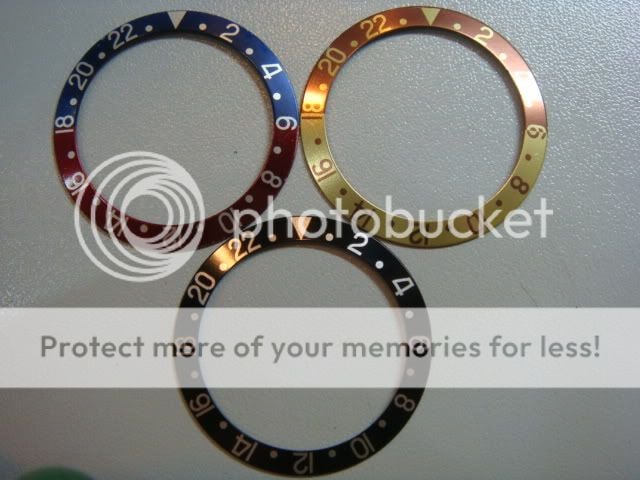
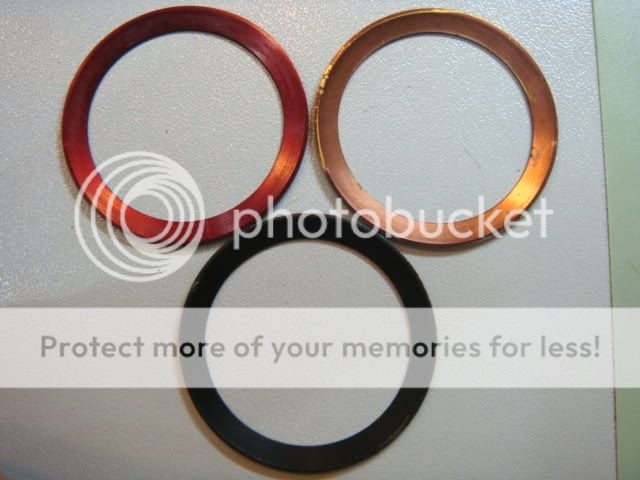
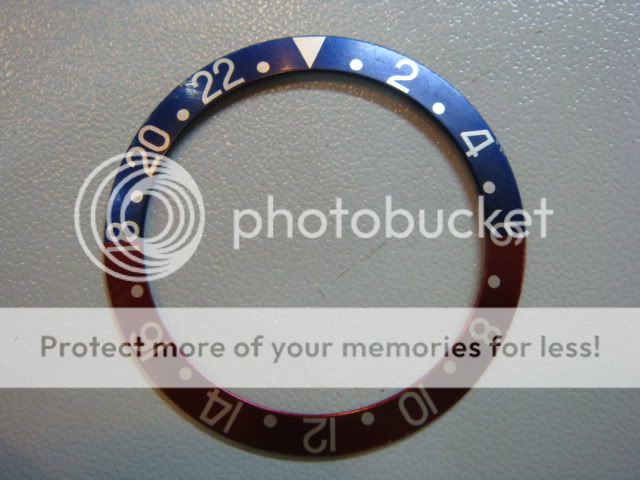
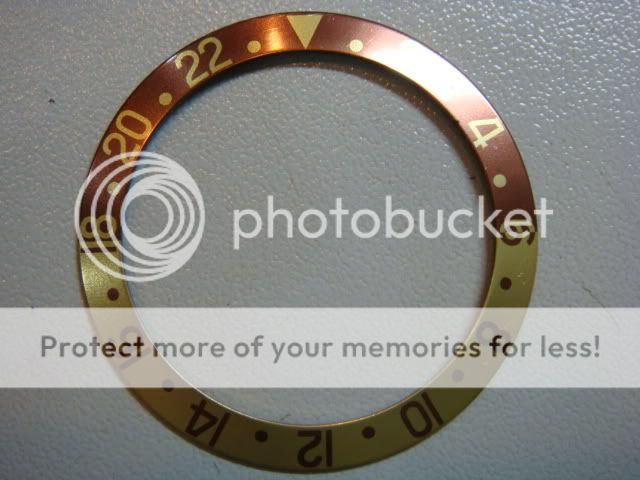
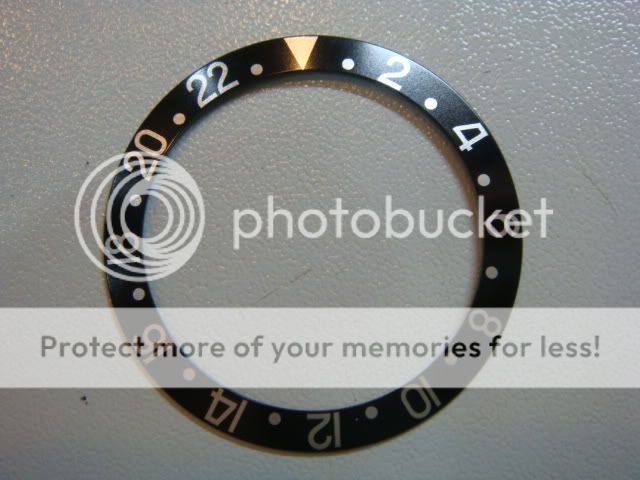
Some MACRO Scans to show...
Frontal PAINT characteristic(Metallic)...for BI-Colour shades.
Frontal PAINT characteristic(Silver/Gold/Brown Metallic)...for Fonts.
Paint surface consist of Tiny Dimples...NOT entirely smooth.
The Gap between "1" n "8" in "18" fonts...
are WIDER(broader) than the Gap between the fonts of "10/12/14/16"...
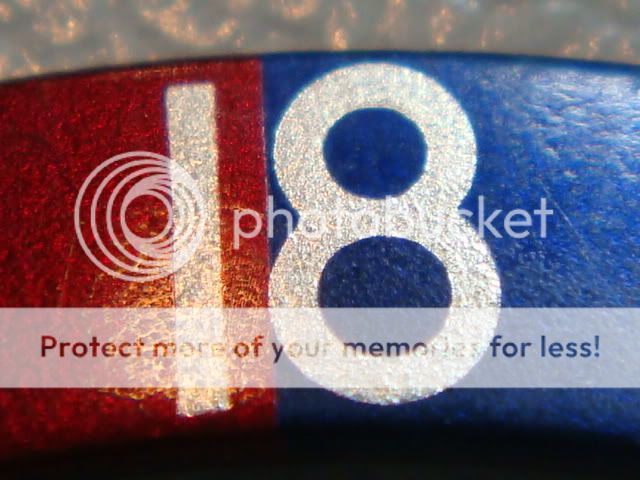
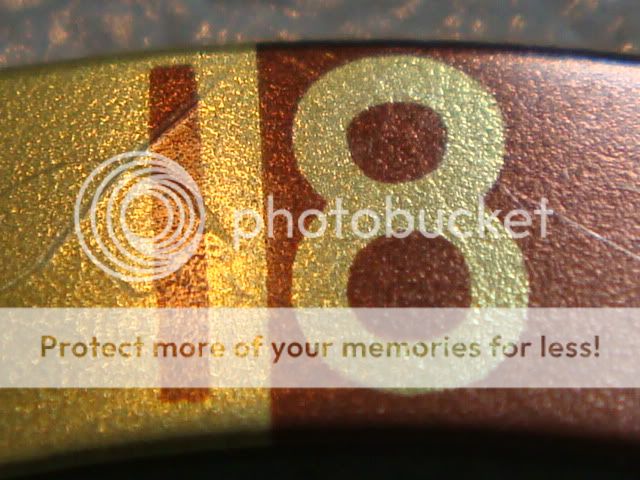
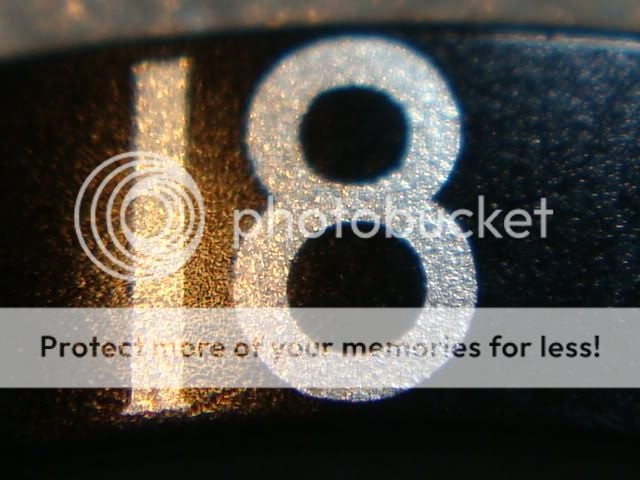
Frontal PAINT characteristic(Metallic)...for BI-Colour shades.
Frontal PAINT characteristic(Silver/Gold/Brown Metallic)...for Fonts.
For Gold Metalic Font of "6"...Border Split is NOT in Straight-Line...
Paint surface consist of Tiny Dimples...NOT entirely smooth.
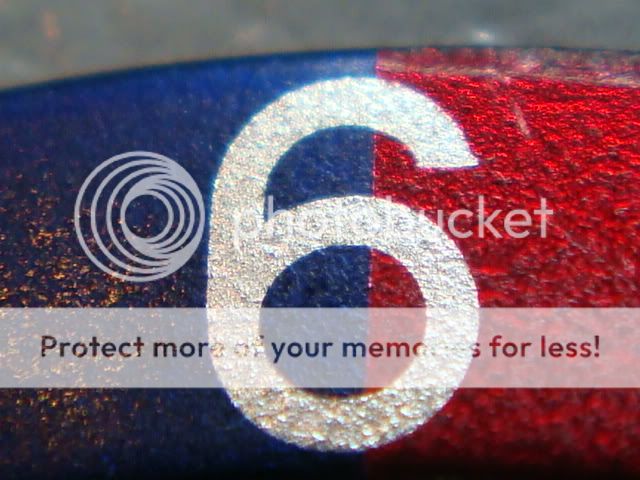
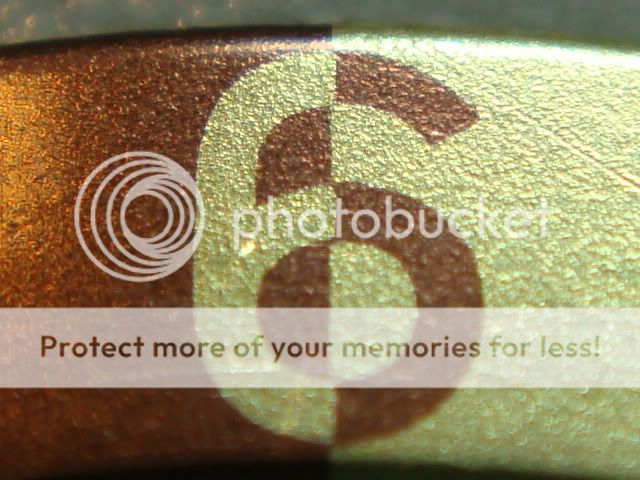
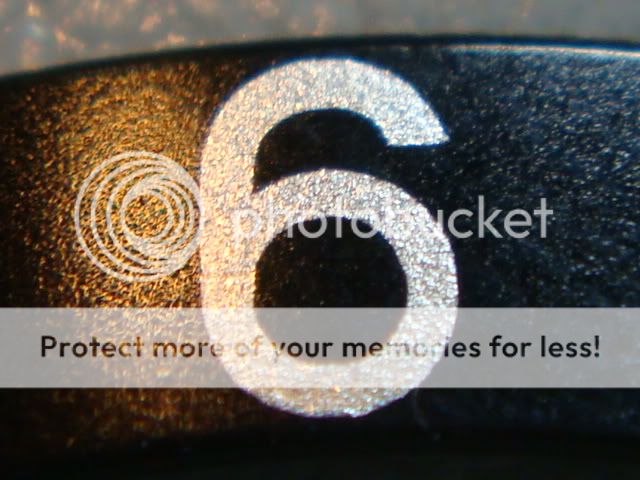
Macro Shots - at the BACK of Bezel Insert...
with distinctive machine tool grooves.
PAINT in RED tone for 1675/16750...METALLIC.
PAINT in BLACK tone for All Black Insert...
(Possible in BLUE tone for 16750...METALLIC.)
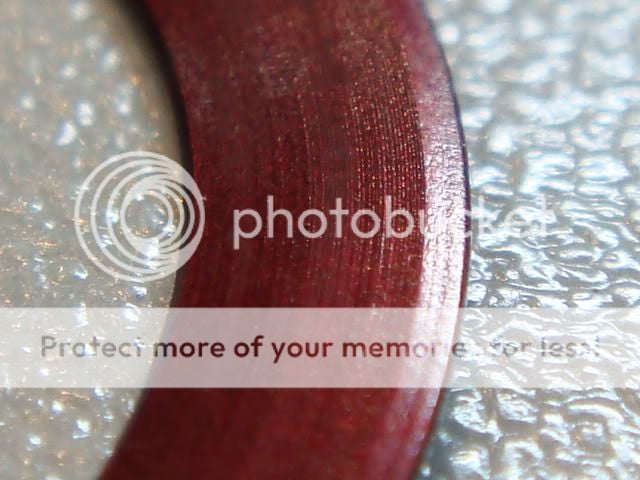
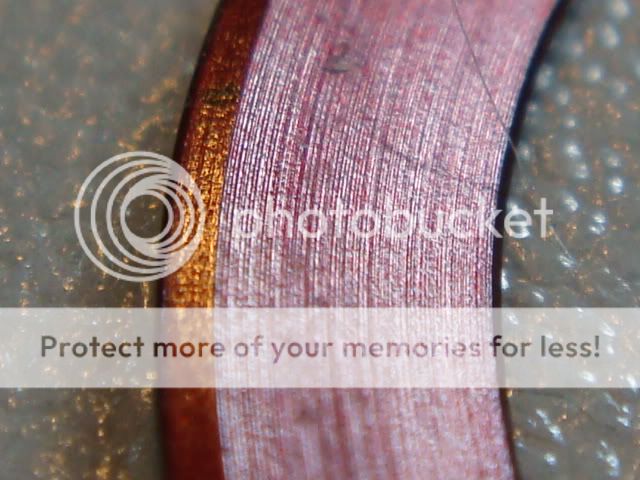
2. Ref 16760/16700...16710/1671x...(Sapphire Crystal).
Physical Dimensions:
Overall Outer Diameter....... = 37.5mm (+-)
Internal Diameter............ = 30.6mm (+-)
Width........................ = 6.9mm (+-)
Thickness.................... = 0.75mm (+-)
http://i234.photobucket.com/albums/ee129/orchipalar/DSC06692.jpg" alt="[linked image]">
(With Serif Fonts on "COKE"..."PEPSI" n All Black Bezel Inserts...
found on Early Sapphire Crystal GMT watches...)
[IMG]http://4.bp.blogspot.com/_O_sITn3l_c8/SWeCdieAwnI/AAAAAAAABF8/0vF_4WxMDJ8/s1600/DSC03751.JPG
Some MACRO Scans to show...
Frontal PAINT characteristic(Metallic)...for BI-Colour shades.
Frontal PAINT characteristic(Silver)...for Fonts.
Paint surface consist of Tiny Dimples...NOT entirely smooth.
The Gap between "1" n "8" in "18" fonts...
are Slightly WIDER(broader) than the Gap between the fonts of "10/12/14/16"...
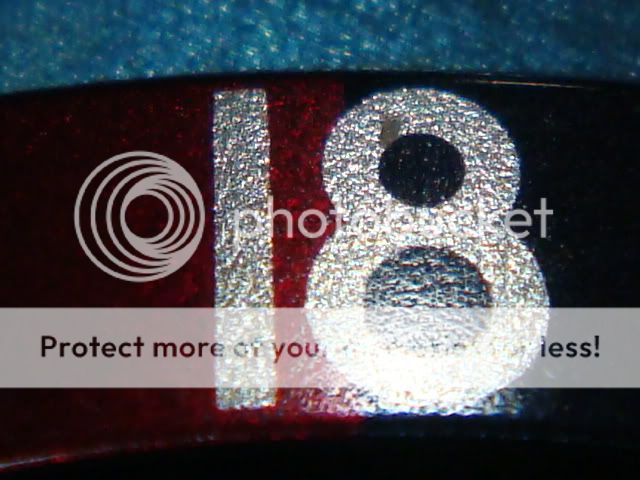
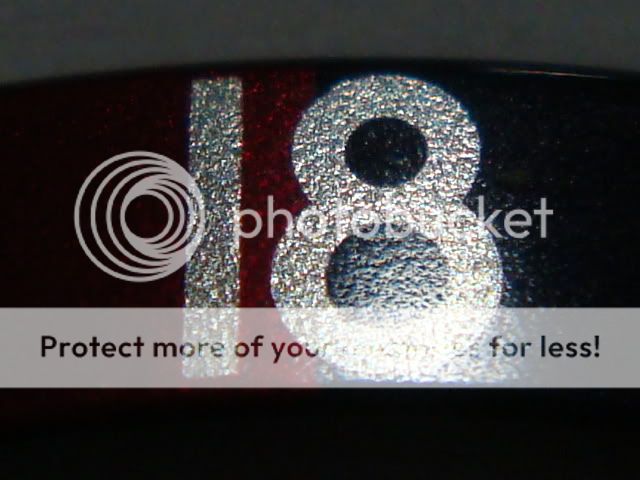
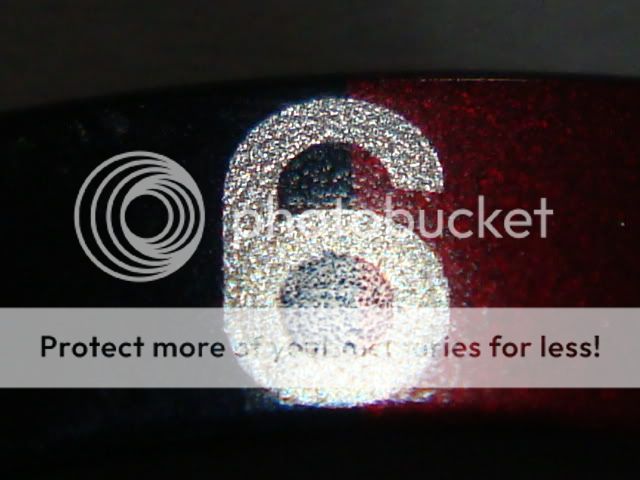
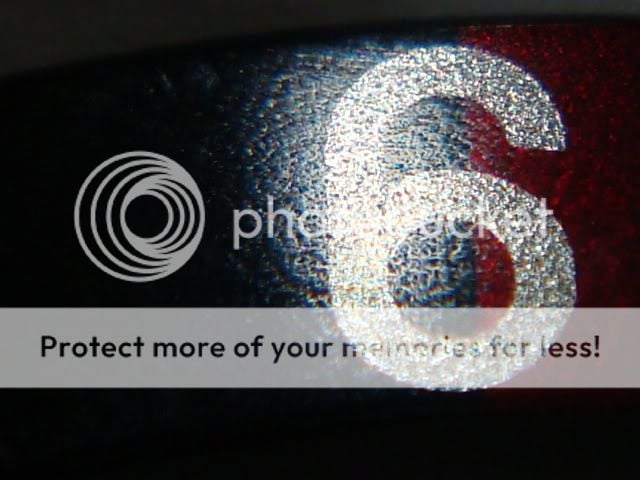
MACRO Shots - taken from the BACK of Bezel Insert...
for Sapphire Crystal GMT watches...
with different levels of machine tool grooves.
The PAINT Color on Insert Back is usually in BLACK tone...only.
BUT Please take NOTE of the 4-Tiers Angled Machining Tool Grooves...
At the 4th Tier...there is the distinctive RIDGE...
which is present at the Base of the Bezel Insert...
This is totally different by comparison with the one that fits...
the Early Plastic Crystal GMT Ref 1675/16750...1675/3...16753.
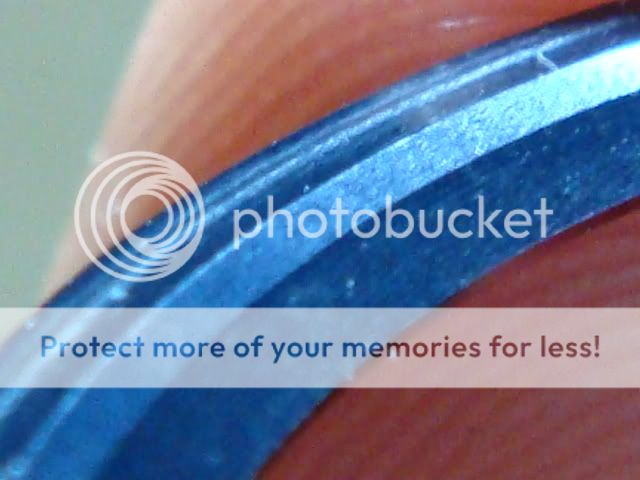



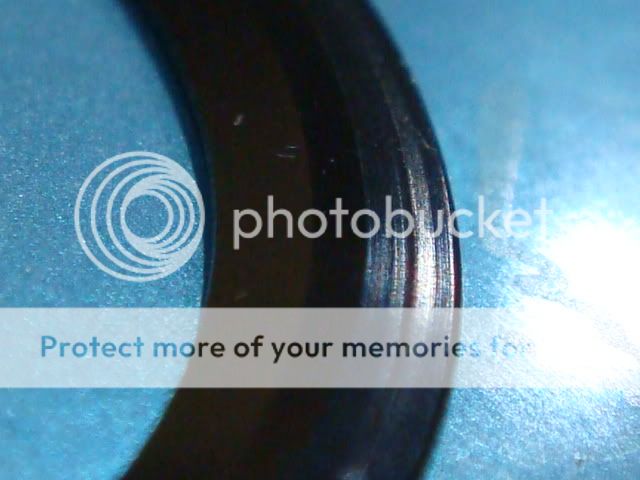



TRF Buddies...please be wary of these Aftermarket ones...
They may look the same...
BUT they are NOT the same Original Rolex...

http://www.network54.com/Forum/20759...13+dial+on+VRM



